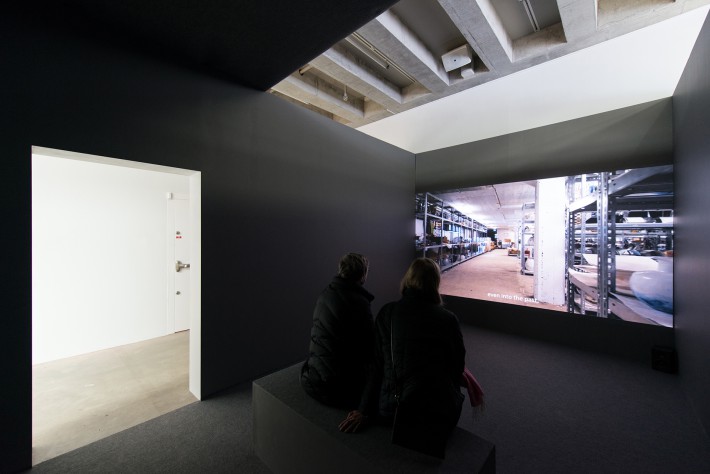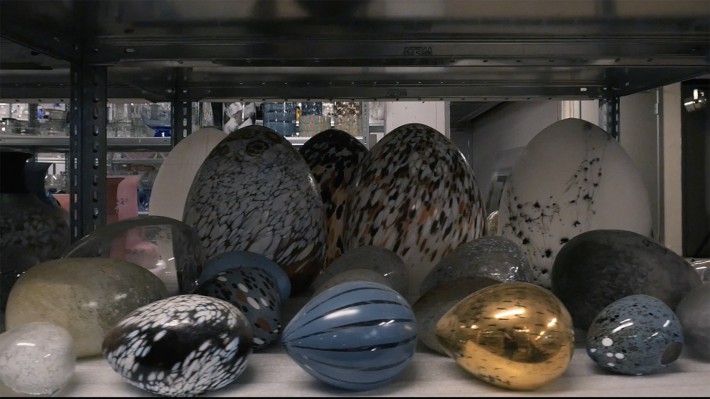Film: Reading Glass, 2015
2015, single channel HD video, stereo sound (music and voice over), 15 mins
Direction, editing, script and narration by Malin Pettersson Öberg

–
Quartz glass, at glass, insulating glass, self-cleaning glass, plexiglass, laboratory glass, crystal glass, berglass, optical glass. The applications and significances of glass for science and modern society are numerous. Glass is found in computers, telephones, glasses and lm cameras. We surround ourselves with buildings of glass. The problem with glass in ancient mes was that it was not transparent. Through experiments with the addition of sodium plants imported from Syria, the Italian glassmaker Angelo Barovier managed to produce clear glass in Venice in the 14th century. He called it ”cristallo”. Even the mirror was invented thanks to glass. Earlier, mirrors had reproduced distorted images, but now, through a mixture of n and mercury, it became possible to produce an entirely flat mirror. Leonardo da Vinci writes that it was the most important inven on for painting. When for the first time you could see yourself, and not just other people, a self-centered society began to emerge. – excerpt from voice-over

In her film Att läsa glaset (Reading Glass), Malin Pettersson Öberg explores glass as a cultural product, invention, concept and association surface with a point of departure in an archive for Swedish glass production. Through glimpses from one slow camera movement along the shelves of the archive, we are met by tableware and art glass from the previous century. To the camera’s concrete reading of objects on the shelves, a second reading of glass through history and literature is added, in the film’s soundtrack. Here, a fragmented narrative is constructed through quotes and references to a number of sources. At regular intervals, the visual flow is interrupted by black gaps, as if to remind us of the eye blinks or the camera that we look through. The camera which, just as the telescopes and spectacles that appear in the film, has helped us see further and beyond the eye, even back in time. The film’s visual flow is accompanied by a musical interpretation composed by Samuel Nicolas (FR). In equal parts document and subjective reflection, Malin Pettersson Öberg wishes to raise questions about the significance of glass. How did it affect Swedish identity and culture, and what impact did it have on the construction of ”Modern” society?
Att läsa glaset has been filmed in the archives of The Glass Factory in Boda, 2015. It features glass designed in the glassworks of Kosta, Boda and Åfors by the following artists: Elis Bergh, Oscar Dahl, R.A. Hickman, Paul Hoff, Anna Ehrner, Klas Göran Tinbäck, Ann Wåhlström, Hertha Hillfon, Monica Backström, Erik Höglund, Gun Lindblad, Bengt Edenfalk, Signe Persson-Melin, Rolf Sinnemark, Fritz Kallenberg, Gabriel Burmeister, Kjell Engman, Ann Wärff, Göran Wärff, Ulrica Hydman-Vallien, Bertil Vallien, Gösta Linderholm, Åsa Jungnelius and Ludvig Löfgren.
–
P R O D U C T I O N
Music: Reversed Bloom, composed by Samuel Nicolas 2015
Voice: Malin Pettersson Öberg
Voice recording: Samuel Nicolas, Conservatoire Maurice Ravel de Villemomble
Camera and light: Axel Diedrichs, Kalmar
Post production: Nils Fridén, Velourfilm
Translation: William Jewson and Malin Pettersson Öberg
Produced with support from: The Swedish Arts Council, The Swedish Arts Grants Committee,
Kalmar konstmuseum, The Glass Factory, Nybro Municipality
as part of the project and exhibition Massa i rörelse (Moving Mass)
Distribution: Filmform – The Art Film & Video Archive
© Malin Pettersson Öberg 2015
T H A N K Y O U
Emma Karlsson, collections and documentation, The Glass Factory, Boda
Agneta Gustavsson, journalist, author and filmmaker, active in the Kingdom of Crystal,
Monica Backström, glass designer and artist, Monica Backström Design, Kalmar, Gunnel Holmér, glass antiquarian,
Kulturparken Småland / Sveriges glasmuseum, Växjö, Åke Bergkvist, artist and former glass engraver
at Strömbergshyttans glasbruk, based in Växjö, Maja Heuer, museum director, The Glass Factory, Boda
Kira Carpelan, MinMamma Produktion
My Lindh, Slakthusateljéerna
Timo Menke, Filmform, Cecilia Björk
The artists behind Massa i rörelse: Ingela Johansson, Johanna Gustavsson Fürst,
Eva Arnqvist, Caroline Mårtensson, Åsa Jungnelius
A D D I T I O N A L M A T E R I A L
Film dialogue and credits, English – Reading Glass
Film dialogue and credits, Swedish – Att läsa glaset
Exhibition catalogue Kalmar konstmuseum, English – Moving Mass
Exhibition catalogue Kalmar konstmuseum, Swedish – Massa i rörelse
Exhibition review, Dagens Nyheter 28/1 2016, Swedish – Arbetsprocesser i historia och nutid
Blog about the project Moving Mass (Swedish/English)